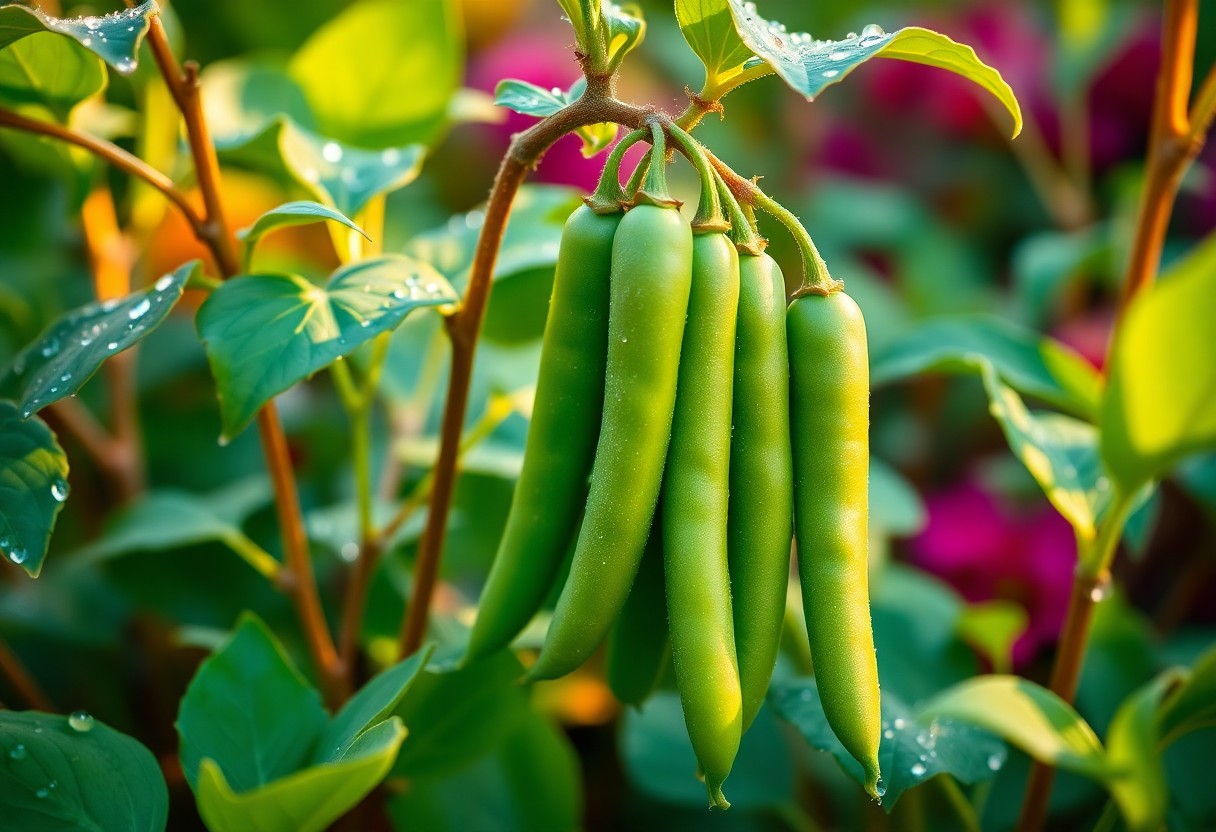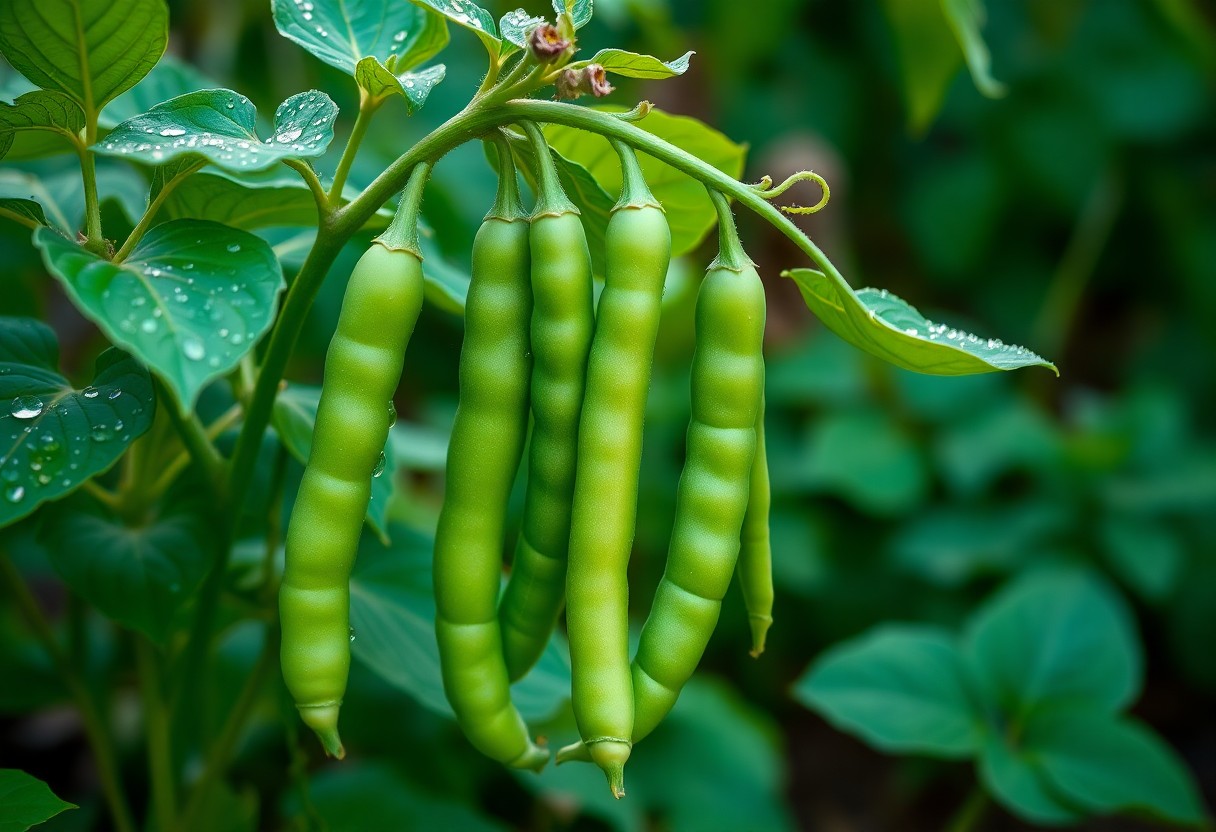Beans can be a delightful addition to your garden, but before you pop those green beans straight into your mouth, you should know a few important facts. While fresh green beans are safe to eat raw, they may contain natural toxins like lectins that can cause digestive discomfort if consumed in large quantities. However, with proper preparation, these crunchy vegetables are not only nutritious but also delicious. In this post, we’ll explore the safety of eating green beans straight from the garden and how to enjoy them to their fullest.
Key Takeaways:
- Freshly picked green beans are safe to eat directly from the garden, but they should be rinsed thoroughly to remove dirt and any pesticides.
- Eating green beans raw may lead to discomfort for some individuals, as they can contain small amounts of lectins, which are neutralized by cooking.
- Harvesting beans in the morning when temperatures are cooler can enhance their crispness and flavor, making them even more enjoyable to eat raw.

Nutritional Benefits of Green Beans
Before you consider snacking on fresh green beans straight from your garden, it’s important to understand their significant nutritional value. Packed with vitamins and minerals, these crunchy veggies can be a fantastic addition to your diet, offering not just flavor but also numerous health advantages.
Vitamins and Minerals
Around half a cup of raw green beans provides a wealth of nutrients, including vitamin C, vitamin K, and folate, which are vital for your overall health. These small but mighty pods also contain minerals like manganese and potassium, important for various bodily functions.
Health Benefits
Around incorporating green beans into your diet can lead to several health improvements. They are low in calories and high in dietary fiber, making them an excellent choice for weight management and aiding digestion.
In fact, by consuming green beans, you may enjoy enhanced heart health due to their high antioxidant content, which combats oxidative stress in your body. Furthermore, their fiber contributes to better blood sugar regulation, making them a smart option for diabetics or anyone looking to maintain stable glucose levels. With all these benefits, adding green beans to your meals not only nourishes your body but also promotes your long-term health goals.
Harvesting Green Beans
Some gardeners find harvesting green beans to be a rewarding part of the gardening experience. Timing your harvest is important to ensure the best flavor and texture of your beans. Picking them at the right moment can make all the difference in your culinary preparations.
When to Harvest
At the right time, green beans should be harvested when they reach about 4 to 7 inches in length and are still firm. You’ll want to check them regularly, as they can become tough if left on the vine too long. Also, look for bright green pods, which indicate that they are fresh and flavorful.
How to Properly Pick
Between harvesting green beans, it’s important to practice gentle picking techniques. Be sure to grasp the bean pod firmly while holding the stem with your other hand, ensuring you don’t damage the plant. Twist the beans off rather than pulling them, which can harm the delicate structure.
Another reliable method for removing beans involves using gardening shears to snip them off, especially if you encounter stubborn pods. This technique helps avoid bruising or breaking the beans. Always wear gardening gloves to protect your hands and consider harvesting in the morning when temperatures are cooler; this helps maintain the beans’ crispness and flavor. Enjoy your harvest in the freshest way possible!
Food Safety Considerations
Not all vegetables are safe to eat straight from the garden, and green beans are no exception. Though they may look fresh and inviting, considering food safety practices beforehand is imperative. Contaminants such as bacteria can be present on the surface, which can pose health risks if consumed without proper precautions.
Pesticides and Chemicals
Across many gardens, the use of pesticides and chemicals can significantly impact the safety of your crops. Even if you are growing organic green beans, it’s wise to check that your gardening practices avoid harmful residues. These substances can end up on the beans and may be harmful if ingested.
Washing and Preparing
Around consuming your green beans, it is important to focus on washing and preparing them correctly. Even if grown organically, it is imperative to wash your beans thoroughly to remove dirt, potential pathogens, and residues. This simple step greatly reduces the risk of consuming harmful microorganisms that may exist on the surface.
It’s advisable to rinse your green beans under cool, running water for at least 30 seconds. Use a vegetable brush to scrub the surface gently, especially if you notice any visible dirt. If your beans were treated with fertilizers or pesticides, soaking them in a solution of water and vinegar for a few minutes can aid in removing residues. Finally, pat them dry with a clean cloth or paper towel before eating or cooking, ensuring you provide the safest option for your meal.
Taste and Texture Factors
Now, when you consider eating green beans straight from the garden, several taste and texture factors come into play. Freshly picked green beans offer a unique experience:
- Crunchy texture
- Earthy flavor
- Natural sweetness
You may notice that the taste can vary based on the variety you choose. Perceiving these characteristics can enhance your enjoyment of this garden-fresh treat.
Freshness and Flavor
On your journey to explore green beans straight from the garden, you’ll find that freshness greatly impacts flavor. Harvesting these beans at their peak ensures they retain their vibrant flavors and nutty undertones, making them an irresistible addition to your meals.
Cooking vs. Raw Consumption
About the preparation methods, you might wonder whether to eat green beans raw or cooked. Both options have their merits, with raw beans providing a delightful crunch and vibrant taste, while cooking can enhance flavor and make them easier to digest.
Taste the difference between raw and cooked green beans by exploring both methods. Eating them raw, you get the benefit of maximum nutrients, while cooking can elevate their flavor profile. However, it’s necessary to be cautious, as certain varieties may harbor toxins when consumed raw. Cooking beans not only elevates their taste but also eliminates any potential dangers, making them safer and more enjoyable. Ultimately, the choice lies in your preferences and culinary creativity.
Common Concerns
Unlike many other garden vegetables, green beans do raise some common concerns among gardeners and consumers. It’s imperative to be aware of these issues to ensure that you can enjoy your fresh beans safely and healthily. These concerns often revolve around digestive issues and potential allergies, both of which can affect your enjoyment of this tasty vegetable.
Digestive Issues
Above all, consuming raw green beans can sometimes lead to digestive discomfort. The beans contain lectins, which can be hard for some individuals to digest if eaten in excess. Cooking green beans typically neutralizes these compounds, making them easier on your stomach. If you have a sensitive digestive system, it may be wise to stick to cooked green beans for your meals.
Allergies and Sensitivities
The presence of potential allergens in green beans means that you should be aware of your own sensitivities. If you have a history of food allergies, particularly to legumes, it’s advisable to proceed with caution. While most people can enjoy green beans without issue, you should watch for any signs of an allergic reaction.
Even if green beans are generally safe for you, pay attention to your body’s signals. Some individuals might experience itchiness, swelling, or gastrointestinal upset after consuming raw green beans. If you do have a known sensitivity, it’s best to avoid raw consumption and opt for cooked beans instead to minimize any adverse effects and enjoy their health benefits fully.

Expert Recommendations
Keep in mind that experts advise thoroughly washing green beans before consuming them to remove any residual pesticides, soil, or bacteria. This practice ensures that you’re eating them safely and healthily. Additionally, while raw green beans are generally safe for most people, cooking them may enhance flavor and digestibility, making for a more enjoyable eating experience.
Best Practices for Eating
Between harvesting and consuming, it’s necessary to handle green beans with care. Always wash them under running water, and consider cutting off the ends before preparing them in your favorite recipe. This ensures a clean and pleasant eating experience, whether you enjoy them raw or cooked.
When to Consult a Specialist
Along your gardening journey, it’s important to consult a specialist if you experience any adverse reactions after eating green beans. This is particularly true if you have a history of allergies or gastrointestinal issues that may complicate your enjoyment of this nutritious vegetable.
Even if green beans are nutritious, you should pay attention to your body’s responses. If you experience symptoms like nausea, vomiting, or abdominal pain after consuming them, don’t hesitate to seek advice from a medical professional. Additionally, individuals with specific allergies should be particularly cautious, as green beans can pose risks for those allergic to legumes or similar vegetables. Prioritizing your health is key to enjoying a diverse and enriching diet.
Summing up
Hence, you can indeed eat green beans straight from the garden, as long as they are fresh and properly washed. Eating them raw provides a delightful crunch and vibrant flavor. However, be mindful that some varieties may be more palatable when cooked, as this can enhance their taste and digestibility. Always ensure your garden beans are free from pests and contaminants to enjoy them safely. Enjoy the fruits of your labor and relish in the fresh flavors right from your garden.
FAQ
Q: Can you eat green beans straight from the garden?
A: Yes, you can eat green beans straight from the garden. Freshly harvested green beans are safe to consume and are often more flavorful and crunchy than those bought at the store. However, it’s important to wash them thoroughly to remove any dirt or pests before consuming.
Q: Are there any health benefits to eating green beans fresh from the garden?
A: Absolutely! Fresh green beans are packed with vitamins, minerals, and fiber. They are low in calories and can help support a healthy diet. Eating them straight from the garden allows you to enjoy their maximum nutritional value without any added preservatives or cooking methods that might diminish their health benefits.
Q: Do green beans need to be cooked before eating?
A: Green beans can be eaten raw, but some people prefer to cook them to enhance their taste and texture. Cooking can also reduce certain anti-nutrients that may inhibit the absorption of some minerals. If you choose to eat them raw, just make sure they are well washed.
Q: How can I tell if my green beans are ready to be harvested for eating?
A: Green beans are typically ready for harvest about 50 to 60 days after planting, when they reach a length of about 4 to 6 inches. They should feel firm and snap easily when bent. If they begin to bulge with seeds, they may be overripe and tougher to eat.
Q: What should I do if I find pests on my green beans in the garden?
A: It’s not uncommon to find pests on green beans. If you spot bugs, you can usually remove them by hand or rinse the beans with a mixture of water and vinegar to deter pests. It’s important to avoid harmful pesticides if you plan to eat the beans raw, so consider using organic methods if you need to treat your garden.
